JOIN OUR EMAIL LIST
Sign up to receive email updates about UNICEF’s work for every child. Get a closer look at UNICEF programs in action, hear about emergency response efforts, and learn how you can help children. You can unsubscribe at any time.


As a valued informant in our two-year journey to explore the potential for a children’s observatory in Canada, we’re pleased to share key developments and invite your continuing collaboration. Our one-year update in July marked the end of our “Discovery Year” and the start of “Design Year”. We’ll provide e-mail updates every couple of months until we’ve completed the process outlined in the calendar below. Every point in our journey involves opportunities for diverse contributors and we are grateful for our fellow travellers.
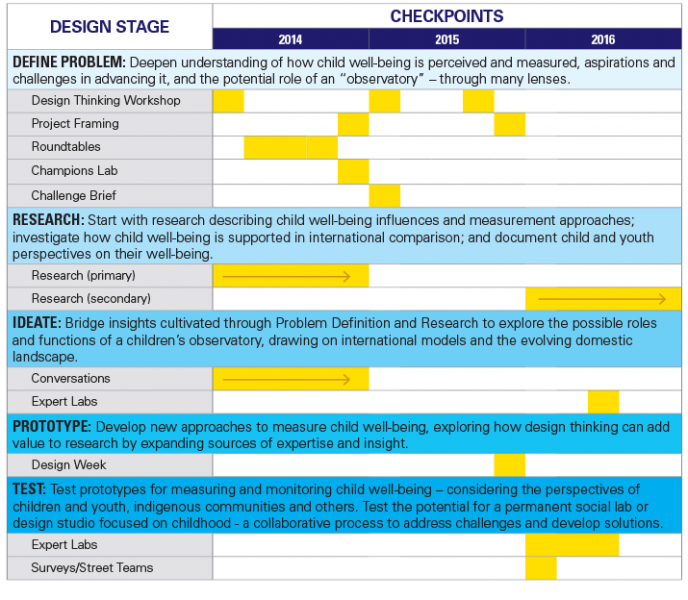
We launched a Research Agenda with the International Institute for Child Rights and Development, Ron Wray and Dr. Nazilla Khanlou, and the Students Commission of Canada, together with a multidisciplinary Research Advisory Group. Key research questions include:
We’ll share the research findings early in 2016.
These recent developments in Canada and worldwide amplify the conversations at the intersection of child well-being, measurement and innovation:
From UNICEF Social Innovation Labs for children, the Wearables for Good Challenge received applications from Canada among the many international designers who have submitted ideas to improve child survival, development and protection. Design thinking helps generate innovative solutions in challenging contexts. While some solutions focus on harnessing new technology, design thinking can also unleash solutions for virtually any type of problem and virtually any type of user – children and youth, policy makers, service providers and private enterprise among them.
UNICEF’s Office of Research – Innocenti celebrates 25 Years of Research and Data for children this year, working with multidisciplinary thought leaders around the world to pioneer new approaches to measuring and understanding child well-being.
In September, the United Nations General Assembly will adopt the Sustainable Development Goals (SDG) – universal targets to support the well-being of all peoples. UNICEF will monitor progress against the indicators of child well-being in Canada and worldwide, including child poverty and infant mortality. States are called on to “increase and use high-quality, timely and reliable data disaggregated by age and other socioeconomic categories relevant in national contexts and to ensure broad access to the tools necessary to turn data into useful, actionable information”. These commitments will help continue the data revolution for children, which started with the collection of administrative data and surveys, by shifting the focus to data literacy, better integration of different data sources and improved use of evidence for decision making.
The Landon Pearson Centre for the Study of Childhood and Children’s Rights released an update in May to the original children’s agenda that followed the United Nations Special Session on Children in 2002. Do children’s needs change or just their priorities? How has our changing society altered the connective tissue that binds our children to their families, in communities, and the collective nation of Canada? We’re exploring these questions, and the Pearson report offers helpful insights about the importance of children’s perceptions of identify and belonging to their sense of well-being.
The Provincial Health Officer and the Special Representative for Children and Youth in British Columbia published their second report on the state of the province’s children, following the first report in 2010 that adapted the UNICEF Index of Well-being to tell stories about growing up in BC.
The Canadian Institute of Child Health and partners released a new module examining the health of newcomer children and youth, who make up 10% of the child population. They tend to engage less in risk behaviours and are less likely to have unhealthy weight than peers born in Canada, but may experience cultural discordance or dissonance which can involve bullying and tension with their peers and parents.
The Fondation du Dr. Julien convened international speakers in Montreal in September to discuss challenges in constructing understanding and measurement of child well-being, and the roles played by the health community and other actors to support children at risk.

Design Week takes place October 4-9 in Waterloo, Ontario, convening 25 thought-leaders with experience in child well-being, measurement, design and communications to develop and prototype new approaches to measuring child well-being, using a facilitated design process including site visits with children and youth. We’ll also get a feel for how a short-cycle design lab works as a collaborative platform to generate rapid solutions. In the months following Design Week, we’ll use mixed methods to test the prototypes and continue to explore how and what an observatory should do, including perspectives from indigenous data experts.
In the Research Agenda, we’ll connect with a range of experts in Canada and internationally through informant interviews and surveys in October-November, to discuss how child well-being outcomes are supported in comparative contexts.
The Canadian Association of Paediatric Health Centres convenes its 2015 conference October 18-20 in Quebec, including a National Symposium – Changing the Game in Determining Health Outcomes. UNICEF Canada’s David Morley will set the stage for panelists with evidence from UNICEF’s Index of Child Well-being to respond to the question, “As a wealthy nation, why are we “stuck in the middle”?

Like many other organizations, we’re really interested in how to address important challenges creatively and effectively. Overlap Associates introduced us to design thinking as an approach to problem-solving. It’s proving to have incredible value to us in exploring the potential for a children’s observatory, so we asked Overlap to contribute a design tip or tool for each update. We hope you find the first of this series thought-provoking - stay tuned for the next!
Design thinking is creativity, in work clothes
I live on a quiet residential backstreet that has suddenly become a favourite detour around summer roadwork. Kids are out playing and people are buzzing through the neighbourhood in a hurry to get downtown.
Residents complained to the city about the danger and the city put up big, ugly orange signs asking drivers to respect the neighbourhood. Then they put up big, ugly orange signs decreeing, “Local traffic only.” Then they added big, ugly orange signs sternly limiting everyone to 30 kph. Traffic was still whipping past, and it was prime road hockey season.
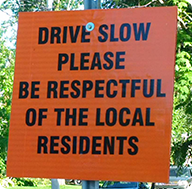
The promise of design thinking
The promise of design thinking is that we can improve complex systems and solve messy problems by leveraging local expertise and stakeholder relationships. Get to know people’s needs better, define problems carefully, test solutions economically, and improve systems continually. Design thinking reduces risk by prototyping improvements—to products, systems and processes—and testing them in real life before rolling them out system-wide.
Why Yoda is directing traffic in my neighbourhood
The city invested a lot of money printing and posting big, ugly orange signs without trying them out. They’re everywhere, but they don’t work. Down my street, some savvy parents said, “Can you come up with better signs?” And for the price of some Sharpies, Coroplast and old garden stakes, they’ve got a variety of signs to slow down traffic, each idea suggested and prototyped by someone close to the problem. By a kid.
Design thinking comes from industrial design, product design, graphic design, architecture, engineering, urban planning… but the methods are universal and there’s nothing “industrial” about it. Nothing could be more human than co-designing solutions with the people who know the problem best.
How do we keep kids safe on the street? In my neighbourhood, someone had the good sense to ask the kids.
Linda Carson
Overlap Associates
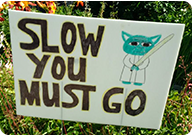
CBC Radio ran a series on The Current about how we design everything around us, not just technology but public spaces, education and even matchmaking: by design is available as a podcast.
Design firm IDEO has done more to popularize design thinking than anyone. ABC’s Nightline segment from 1999 is a good introduction, Stanford’s d.school offers a 90-minute crash course online, and IDEO recently launched an online guide to human-centred design. You can read an overview in Fast Company, or bookmark the Methods page for yourself. Most of the publicity about design thinking focuses on products and start-ups, so this article by Sarah Soule at the Stanford School of Business about social entrepreneurship is a refreshing reminder that we design systems, policies, services and not-for-profit activities, too.

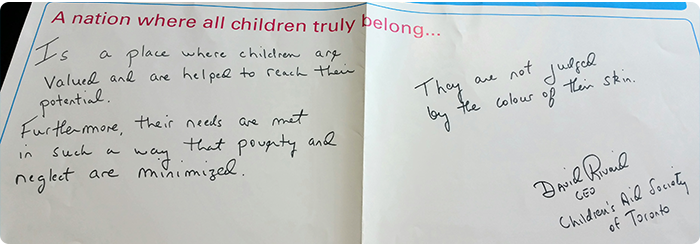
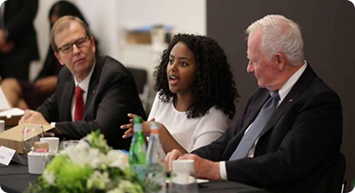
David Morley, Hannah Godefa, and His Excellency the Right Honourable David Johnston at the Champion's lab, September 2014.
E-mail us at policy@unicef.ca with questions and suggestions – we would love to hear from you.
You are receiving this update because you participated in our activities. Please let us know if you don’t wish to receive future updates (policy@unicef.ca).